SEMLI RESEARCHER WINS AWARD FOR PRESENTATION AT WORLD PHYSIOTHERAPY CONGRESS 2021
Posted on April 12, 2021
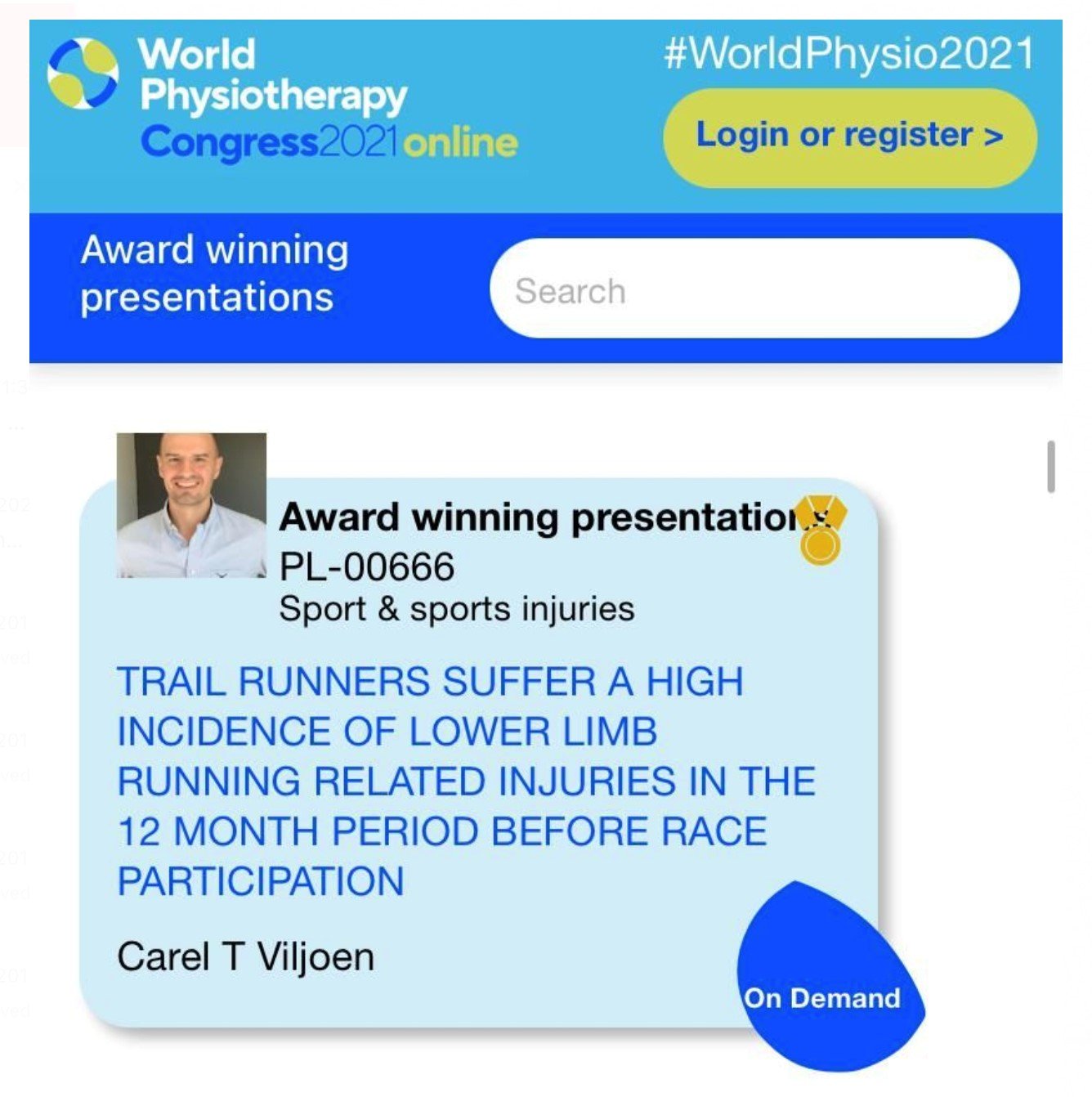 Mr Carel Viljoen, a Physiotherapist at SEMLI (Sport, Exercise Medicine and Lifestyle Institute at the University of Pretoria) who is also completing his PhD at the University of Pretoria delivered an award-winning presentation at the 2021 World Physiotherapy Congress on 7 April 2021. The presentation shared research published this year in Physical Therapy in Sport on the injuries sustained by race entrants during the 12 months training preceding the 2019 SkyRun race.
Mr Carel Viljoen, a Physiotherapist at SEMLI (Sport, Exercise Medicine and Lifestyle Institute at the University of Pretoria) who is also completing his PhD at the University of Pretoria delivered an award-winning presentation at the 2021 World Physiotherapy Congress on 7 April 2021. The presentation shared research published this year in Physical Therapy in Sport on the injuries sustained by race entrants during the 12 months training preceding the 2019 SkyRun race.
Trail running is a demanding sport that allows avid runners to conquer varied and challenging natural terrain (mountain, desert, forest), in all sorts of weather conditions. Despite its popularity, trail running has not been well researched, but Section Sports Medicine and the Department of Physiotherapy in collaboration with Vrije University in Amsterdam and SEMLI, the Sport, Exercise Medicine and Lifestyle Institute at the University of Pretoria, is looking to change that. Physical activity in outdoor environments has been shown to have a positive impact on mental wellbeing, and although running has multiple proven health benefits, a high risk for injury remains. Researchers at SEMLI have been investigating the injuries, illnesses and other medical complications experienced by trail runners. This is an effort to help guide the development of injury and illness prevention strategies for trail runners, as well as medical support strategies for event organizers on race day.
Driven by the principal investigators (Carel Viljoen and Prof Christa Janse van Rensburg) of the trail running research project, a recent review published by this group suggests that the foot is the most common anatomical site of trail running injury followed by the knee, lower leg, thigh, and ankle. Skin lacerations/abrasions are the most common injury diagnoses, followed by skin blisters, muscle strains, muscle cramping, and ligament sprains - although most injuries are of minor severity. The most common trail running illnesses reported relates to the gastro-intestinal tract (GIT), followed by the metabolic and cardiovascular systems. Symptoms of nausea and vomiting related to GIT distress and dehydration are commonly reported, although most illnesses are also of minor severity.
Another study by this group looked specifically at trail runners competing in the SkyRun races (38 km, 65 km or 100 km) in South Africa in 2019. The participants were asked to complete a pre-race medical screening questionnaire that included details of injuries they had sustained in the previous 12 months. Data collected showed that approximately 1 in every 4 SkyRun trail runners reported at least one injury in the 12 months leading up to the race. Most of these injuries (nearly 90%) occurred in the lower limb, with the knee, ankle and foot being the most commonly injured areas; and tendinopathy, joint sprain and muscle injuries being the most common pathology types reported. Based on these results, the researchers emphasized the need to establish injury risk factors to assist in the design of specific injury prevention strategies, as the recurrence of injury during a trail running race may have dire consequences.
Publications related to this article:
Epidemiology of Injury and Illness Among Trail Runners: A Systematic Review. Sports Medicine, 2021 Feb 4.
Carel T. Viljoen, Dina C. Janse van Rensburg, Evert Verhagen, Willem van Mechelen, Rita Tomás, Marlene Schoeman, Susan Scheepers, Elzette Korkie
https://pubmed.ncbi.nlm.nih.gov/33538997/
One in four trail running race entrants sustained an injury in the 12 months training preceding the 2019 SkyRun race. Physical Therapy in Sport 47 (2021) 120-126.
Carel T. Viljoen, Dina C.(Christa) Janse van Rensburg, Audrey Jansen van Rensburg, Evan Booysen, Shihluke Chauke, Petro Coetzee, Amy Hurlimann, Mignette Jooste, Yoliswa Nibe, Chene Schulenburg, Elzette Korkie, Dimakatso Ramagole, Catharina Grant, Tanita Cronje
https://pubmed.ncbi.nlm.nih.gov/33254101/
Published by Jill Borresen
UP’s SEMLI launches research study on returning to sport after COVID-19
Posted on August 06, 2020
A study on the effects of COVID-19 and other respiratory infections on athletes returning to training and competition is being launched by the Sport, Exercise Medicine and Lifestyle Institute (SEMLI) at the University of Pretoria (UP) in association with the International Olympic Committee (IOC) Research Centre of South Africa.
The Athletes With Acute Respiratory InfEction (AWARE) research study will be done in collaboration with local academic institutions (South African Medical Research Council, Stellenbosch University and University of the Witwatersrand), international academic institutions as well as sports organisations such as the IOC, FIFA and World Rugby, among others.
“Since the first case of the novel coronavirus (SARS-CoV-2) was described in late 2019, the COVID-19 pandemic has added an unparalleled and extraordinary threat to the health of all people, including recreational and professional athletes around the world,” says Professor Martin Schwellnus, Director of SEMLI.
About 50% of all acute illness in athletes during competitions and tournaments affect the respiratory tract, he explains. Some acute respiratory infections, such as COVID-19, negatively affect multiple organs in the body, which can cause a drop in exercise performance and increase the risk of medical complications occurring during exercise.
As lockdown restrictions are gradually lifted, the SEMLI community is being called on to urgently advise and guide organisations and individual athletes on how they can safely return to sports training and competitions following a COVID-19 infection.
“The current return-to-play guidelines for athletes are an adaptation of a clinical tool known as the ‘neck check’, where the decision to exercise or not is based on symptoms and signs being either localised (above the neck) or systemic (below the neck),” explains Prof Schwellnus. “But limited research data supports its use, and the use of this tool to guide return-to-play following COVID-19 has been questioned.”
There is increasing evidence that the virus can affect multiple organs including the lungs, kidneys and heart, and increases the risk of blood clot formation. There might also be neurological symptoms and potential negative effects on skeletal muscle. There is, however, no data that determines whether the negative effects on organs are exacerbated in athletes as they return to full training and competition.
“Such residual symptoms might not affect only sports performance but could increase the risk of medical complications occurring during high-intensity exercise,” Prof Schwellnus says. “The decision as to when it is safe for an athlete with recent or current symptoms of an acute respiratory infection to return to exercise remains one of the most challenging clinical decisions for a sport and exercise medicine physician or health professional involved in the management of athletes.”
The AWARE research study aims to answer these questions by tracking the symptoms and recovery of athletes after they have experienced a recent acute respiratory infection, including COVID-19. This will allow guidelines to be established that health professionals around the world can use to advise competitive and recreational athletes as they return to sport after COVID-19 or some other respiratory infection.
SEMLI is inviting athletes who compete at all levels and in different sports to be part of this important research, including:
- elite/professional, competitive and recreational athletes (those participating in community-based sports events, and who regularly train a minimum of 3 hours per week or under the guidance of a coach), with or without disability;
- athletes between 18 and 60 years of age;
- athletes who have had any symptoms of a respiratory infection (any flu-like illness including COVID-19) in the past six months, such as a sore throat, blocked or runny nose, cough, loss of smell or taste, difficulty breathing, chest pain, fever or chills, excessive tiredness or unexplained general muscle/body pain; or
- athletes who have had a COVID-19 test in the past six months (with or without symptoms).
Participants will be asked to complete an online questionnaire about their history of symptoms that are suggestive of a recent acute respiratory infection, including COVID-19.
For more information about the study and how to become involved, contact: [email protected].
The current list of collaborators in the AWARE study includes:
- International Olympic Committee (IOC)
- Federation Internationale de Football Association (FIFA)
- World Rugby
- IRONMAN Argentina
- University of Melbourne
- Copenhagen University Hospital
- South African Medical Research Council (SAMRC), Biostatistics Unit
- Institute of Sport and Exercise Medicine (ISEM), University of Stellenbosch
- Wits Institute for Sport and Health (WISH), University of the Witwatersrand
- SA Rugby
- South African Sports Medicine Association (SASMA)
- Author Primarashni Gower
UP unveils world-class Biomechanics Lab
Posted on October 18, 2019
The University of Pretoria’s (UP) Sport, Exercise Medicine and Lifestyle Institute (SEMLI) recently opened the doors to its new Biomechanics Lab, which is already providing support services to TuksSport’s first teams as well as elite track and field athletes, some of whom participated in the recent World Championships.
Biomechanics as a core sub-discipline of sport science is the study of human movement in order to minimise the risk of injury and improve the performance of sportspeople.
“One of the main objectives of the lab is to offer biomechanical analysis to anyone who wants to perform to their maximum capacity in their chosen sport, while minimising injuries,” explains Dr Helen Bayne, head of the lab. The new facility will also enable translational research that informs the practice of coaching, exercise training, and the prevention and management of injuries.
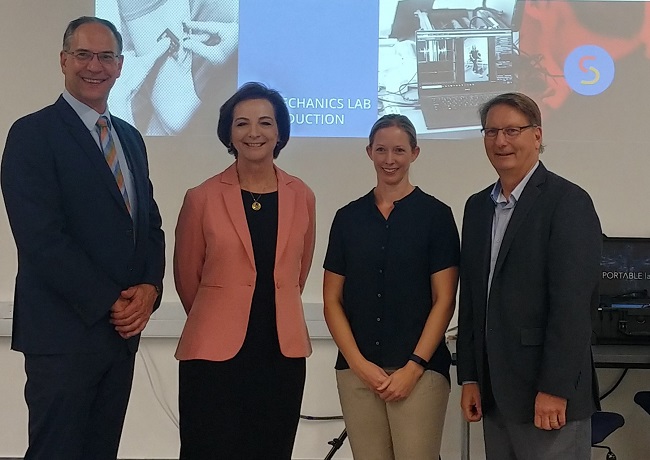
From left to right: Prof Tiaan de Jager (Dean of the Faculty of Health Sciences), Prof Stephanie Burton (Vice-Principal for Research and Postgraduate Education), Dr Helen Bayne and Prof Martin Schwellnus (Director of SEMLI) at the opening of the Biomechanics Lab.
“The assessment of biomechanics ranges from basic descriptions of motion to complex analyses of forces and torques produced at specific joints,” Dr Bayne adds. “This information can be used to guide coaching, conditioning or therapeutic interventions to improve performance, reduce injury risk and enhance rehabilitation.” A wide range of tools is used to provide this information, including high-speed video cameras, 3D motion-capture systems, electromyography, radar guns, force plates and inertial measurement units.
While this sort of support system for athletes is a standard facility abroad, it is rarely found in South Africa. The Biomechanics Lab, which forms part of SEMLI’s Sport Science unit, is a world-class facility that puts SEMLI in a position to compete with international high-performance institutes. SEMLI’s integrated approach to research, teaching and services is what sets the institute apart; the lab is a valuable addition to its comprehensive set of multidisciplinary services.
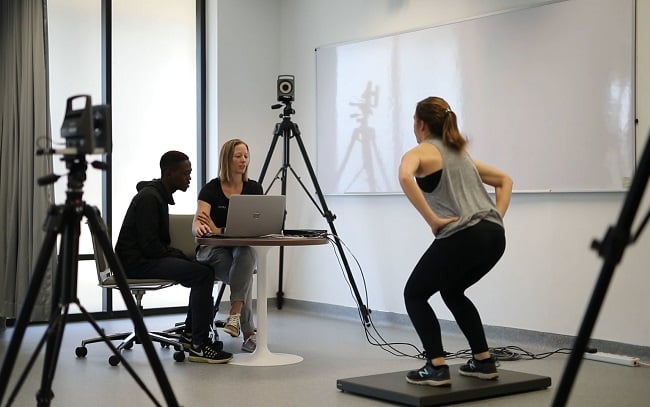
Biomechanics as a core sub-discipline of sport science is the study of human movement in order to minimise the risk of injury and improve the performance of sportspeople.
The introduction of the lab not only strengthens the undergraduate sport science curriculum, but also opens many new doors for postgraduate studies. “The biomechanical theory that is taught in undergraduate degrees underlies the applications that will run in the lab,” says Dr Bayne. “The students will be able to experience practical demonstrations of the topics they learn about, getting hands-on experience with the tools and analyses to apply their knowledge.”
The facility provides a space for sport science postgraduates to pursue specialist studies in biomechanics and enables applied sport scientists to put biomechanics into practice. Some of SEMLI’s current research is looking into how footwear can affect running mechanics; cycling biomechanics and knee pain; and improving running with strength, speed and power.
“We hope the Biomechanics Lab will contribute to a range of disciplines in not only the Sport Science and Health Sciences fields, but across other faculties too,” says Dr Bayne.

The Biomechanics Lab is a world-class facility that puts SEMLI in a position to compete with international high-performance institutes.
Plans are also in place for biomechanics services to be made available to the public in the near future. Some of these services include a 3D gait analysis, which allows for the assessment of runners’ movement patterns related to injury; a dynamic bike for cyclists that uses 3D motion-capture technology; and a testing package for maximum strength and power, which has implications on performance across a variety of sports. “We will also implement procedures to monitor and assess progress after injury or surgery to improve the return-to-sport process.”
- Author Louise de Bruin
UP TIPS study helps make rugby players healthier to perform in tournaments
- TuksSport
- News
- UP TIPS study helps make rugby players healthier to perform in tournaments
Posted on October 03, 2019
The largest prospective study on illness in rugby union players has revealed that 70% of the players studied in just one season’s Super Rugby Tournament reported illness at some time during the tournament.
Professor Martin Schwellnus, Director of the University of Pretoria’s (UP) Sport, Exercise Medicine and Lifestyle Institute (SEMLI), was the lead researcher in this international collaborative study, which took place between 2010 and 2016. During this time, 1 340 male professional rugby players were assessed.
He explained that a medical illness in this study’s case was regarded as “any non-trauma-related symptom or sign presenting in a player that required medical attention from the team physician on a specific day”. Examples of illness include respiratory tract infections and gastro-intestinal infections. Player availability is linked to team success, making the maintenance of a team important.
The Super Rugby Tournament is an annual event lasting about 16 weeks, with intense training sessions and weekly matches. On top of this, players travel between countries with time zones varying between two and 11 hours. Prof Schwellnus said international travel across multiple time zones also increases the risk of illness.
A previous SEMLI study showed that international travel across multiple time zones during the 2010 tournament increased the risk of illness two to three times during “away” time periods.

Professor Martin Schwellnus.
“The reasons for this observed higher incidence of illness was not clear but could be attributed to a number of different factors including: the prolonged and strenuous nature of the competition; exposure to different environmental conditions (temperature, humidity, atmospheric pollution) and variation of diet.” said Prof Schwellnus. Players travelling between continents may also be exposed to different strains of pathogenic organisms.
He said, “Acute illness can increase the risk of serious medical complications and even sudden death during strenuous exercise.”
The study had a second part to it – it is also the largest one on an illness-prevention programme undertaken in international sport. In an effort to reduce the incidence of acute illness during the Super Rugby Tournament, Prof Schwellnus and his team developed the Team Illness Prevention Strategy (TIPS), which showed positive results among players.
The TIPS study spanned seven seasons, studying six South African teams playing in the Super Rugby Tournament. It worked closely with team physicians who collected illness data on a daily basis during competition periods.
Since its intervention, TIPS has been associated with a 59% reduction in overall incidence of illness during the Super Rugby Tournament, with a significant reduction in illness of all commonly affected organs. Prior to this intervention, previous studies showed a high overall illness rate during a season of this tournament, with respiratory tract infections and gastro-intestinal infections being the most common. Respiratory tract infections accounted for more than 75% of infective illnesses.
The efficacy and success of the TIPS strategy was in “its pragmatic approach to illness prevention in a demanding (intense and long) rugby tournament that required teams to undertake both domestic and international long-haul travel”, said Prof Schwellnus. Further to the success in reducing illness among players is the co-operation and involvement of team medical staff, management as well as athletes implementing TIPS.
The strategy’s pragmatic approach involves elements that are easy to implement, with pre-screening of players before a tournament and good hygiene practices to reduce infection and illness. Prof Schwellnus said: “Team physicians could consider local antimicrobial spray, probiotics and, in some cases, prophylactic antibiotics to reduce the risk of infection, particularly respiratory tract and gastro-intestinal infections.”
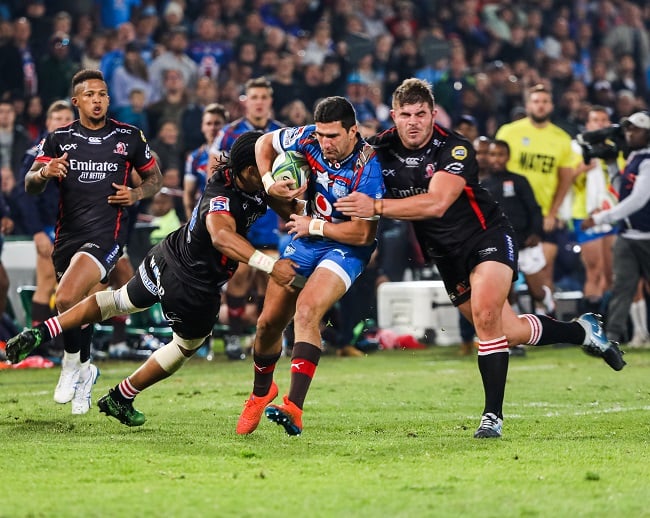
Super Rugby Lions vs Bulls match at Loftus. (Shutterstock)
The pre-screening is standard medical screening performed by the team physicians and is based on guidelines from World Rugby. It includes general medical and injury history and medication/supplement use by the athlete. Prof Schwellnus said the primary components look particularly at players who have an increased risk of illness. “This could include a past history of respiratory infections, allergies, known gastrointestinal illness or known dermatological conditions.”
TIPS discourages players from sharing utensils or water bottles and encourages regular hand washing and the use of personal antiseptic hand gel. Players should also ensure they are getting enough sleep. Furthermore, they should avoid continuous exposure to air-conditioned or polluted environments. “Players could also consider taking a high dose of Vitamin C (>1 000mg/day) during tournaments.” It is essential that symptoms are reported early, so that early isolation of players is implemented at the onset of symptoms.
Because of international travel across multiple time zones, Prof Schwellnus recommended players consider prophylactic local anti-microbial spray, probiotics and antibiotic prophylaxis – medication used to prevent a disease from occurring in specific cases. This is to boost their immune system and reduce the risk of infection, particularly respiratory tract and gastro-intestinal infections.
While a similar study was conducted among the UEFA Champions League Football players over multiple seasons, the TIPS intervention leads to lower incidences of illness among Super Rugby players compared to that reported in the UEFA League.
“The findings from the TIPS intervention therefore have important clinical implications for other travelling sport teams,” said Prof Schwellnus. Although this study was carried out on Super Rugby teams, the researchers see potential application in other sports tournaments such as the Olympic Games and future Rugby World Cups, with the aim of producing illness-free players and athletes
- Author Louise de Bruin
UP SEMLI study reduces life-threatening medical emergencies during endurance events by 64%
Posted on January 16, 2019
A first-of-its-kind study conducted by Professor Martin Schwellnus of the University of Pretoria’s Sport, Exercise Medicine and Lifestyle Institute (SEMLI), in partnership with UCT, the MRC Biostatistics Unit and Professor Wayne Derman of Stellenbosch University, has led to a 64% reduction in life-threatening medical emergencies encountered during marathons and other major endurance events. The study – which used an online medical screening and education intervention tool ahead of race day – found that other medical encounters, including all types of injuries, were reduced by 29%.
The results could have significant implications for and reduce deaths at some of South Africa’s favourite mass sports events such as marathon races, half-marathons, and cycle tours. Thousands of participants in these popular events end up in the medical tents annually, reporting serious life-threatening medical emergencies and overwhelming the healthcare system on the day. The results of Prof. Schwellnus’s study have been so impressive that the international community of athletics, triathlon and cycling have shown interest in incorporating this system into their registration processes for their mass community-based sporting events.
“Medical emergencies at mass sporting events are not just innocuous occurrences, but significant and severe encounters that are happening more often than they should be,” says Prof. Schwellnus, Director of UP’s SEMLI, who has been working in these medical tents for the past 25 years. Prof. Schwellnus, previously at the University of Cape Town, led this study, with the overall objective of making mass community-based endurance events safer for all participants.
The study introduced an online pre-race medical screening and educational intervention programme over an eight-year period in one of Cape Town’s world-favourite sporting events, the Two Oceans Marathon. Over the eight years, the researchers studied the 153 208 Two Oceans race starters in both the 21km and the 56 km events. The first four years comprised a control period, looking at the type of medical encounters that occurred, and the number of runners participating.
After this control period, Prof. Schwellnus and his team introduced an online pre-race medical screening which was based on the European Association for Cardiovascular Prevention and Rehabilitation (EACPR) pre-exercise screening guidelines and included other risk factors identified by the research team. Each person who completed the pre-race screening was categorised into one of four categories, with “Very High Risk” and “High Risk” being the flag categories. People in these categories would receive educational intervention programmes.
The educational intervention programme was specifically targeted at the two flagged categories, and there was also a general educational intervention for all runners. “The targeted educational intervention emails included information about what the runner’s doctor should test that individual for, because often doctors are not even aware of the specific risk factors experienced during prolonged moderate- to high-intensity exercise,” Prof. Schwellnus explains.
The risk of a medical encounter, including sudden death, during such prolonged moderate- to high-intensity exercise is related to extrinsic factors, including environmental stress and race distance, and also intrinsic factors such as older age. Underlying chronic disease such as heart disease and diabetes and risk factors for chronic disease also put an individual at greater risk for medical complications during such events.
“It is of utmost importance to ensure medical support is of the highest standard on race day, so that if someone goes into sudden cardiac arrest a medic is there to assist, and there is a good chance of resuscitation,” Prof. Schwellnus says. “But we want to prevent runners from even getting to that point. This online medical screening focuses on prevention rather cure.”
Educating people about their health and their possible risk factors is vital, because cardiac arrest and other life-threatening encounters won’t necessarily only happen on race day, but could also happen during a training run. Runners therefore needs to be as informed about their health as possible, particularly when they fit into the high-risk profile.
This pre-race medical screening system and educational intervention programme is easy to implement and – with a significant 64% reduction in all medical encounters since its introduction – it’s not only saving lives but also contributing to improved race safety.
This study at SEMLI forms part of a series of SAFER (Strategies to Reduce Adverse Medical Events for the Exerciser) studies which aim to better understand what is happening at these mass community events, who is participating, and what their risk profiles are – all in an effort to ensure safer participation so that the numerous health benefits of physical activity continue to outweigh any health risks.
- Author Louise de Bruin
Popping painkillers before endurance events can cause severe long-term damage – UP study
16 November 2018
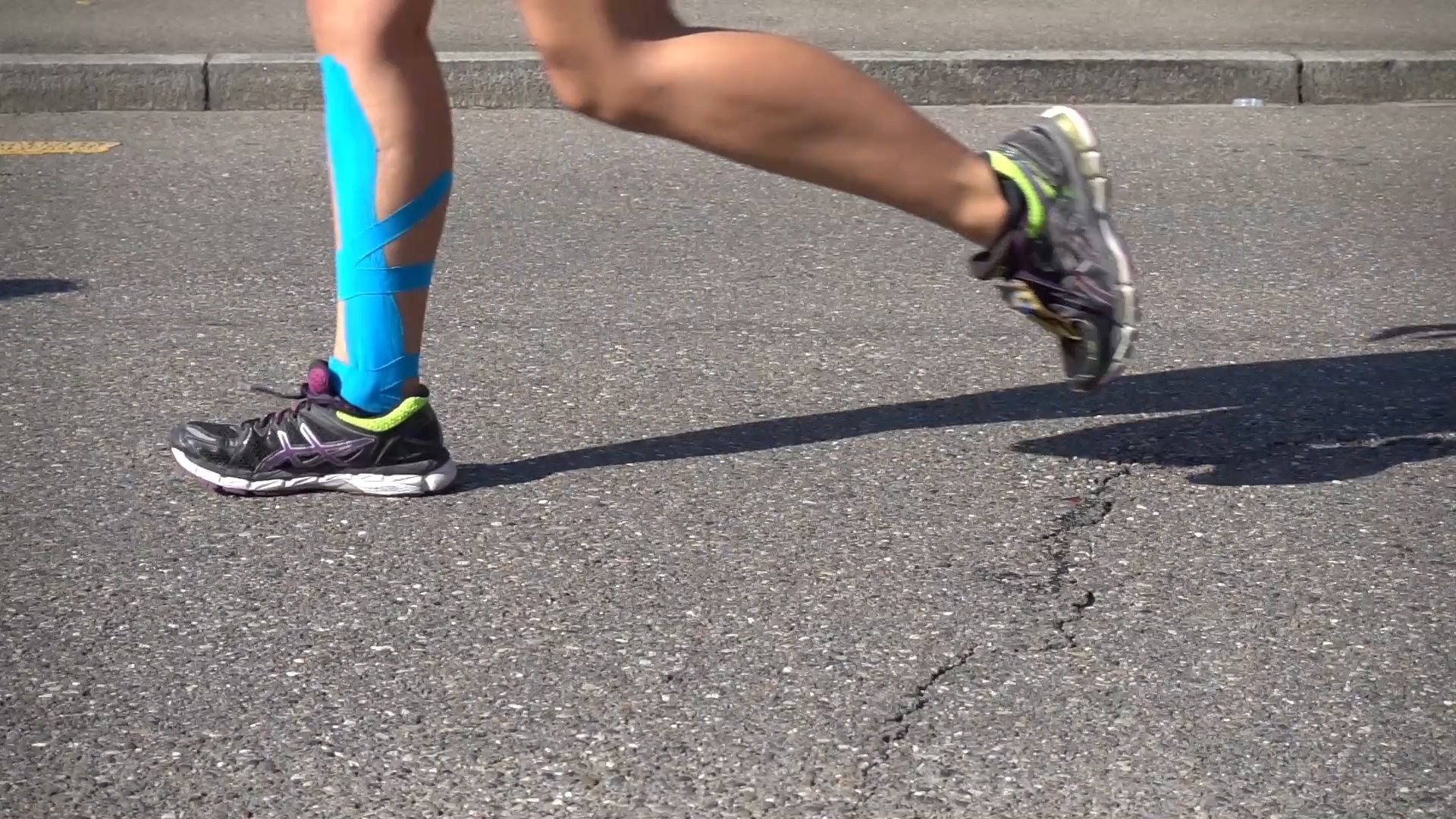 For the average marathon runner, excruciating pain is often inevitable during endurance runs, and popping a few painkillers before or during a race to make the pain more bearable seems like a no-brainer and is quite common.
For the average marathon runner, excruciating pain is often inevitable during endurance runs, and popping a few painkillers before or during a race to make the pain more bearable seems like a no-brainer and is quite common.
But a recent collaborative study by UP Sport, Exercise, Medicine and Lifestyle Institute (SEMLI) has raised concerns that neither athletes nor race organisers realise the severity and health risks of taking painkillers at the starting line and during the race.
“Runners are using these medicines for pain relief, injury prophylaxis, completing the race, faster recovery and because they’re under the impression that it will result in an earlier return to training after injury or improve athletic performance,” says SEMLI Director Professor Martin Schwellnus.
But the adverse consequences and side effects of these drugs – known as analgesic/anti-inflammatory medication (AAIM) – are often greatly underestimated. “Many are over-the-counter options and self-administered by athletes before or during events without a doctor’s involvement,” adds Prof Schwellnus, “so these individuals do not get the necessary information about the dangers of the drugs.”
This first-of-its-kind study, conducted by UP sport and exercise medicine postgrad Adrian Rotunno under the supervision of Prof Schwellnus and Prof Christa Janse van Rensburg, focused on 76 654 runners who had entered the annual Old Mutual Two Oceans Marathon in Cape Town, which comprises a half-marathon (21km) and an ultramarathon (56km). The study sought to gain insight into partcipants’ health, medical history and use of AAIM.
Consenting participants completed an online questionnaire, and provided their medical history – which included information about cardiovascular disease (CVD), cancers and allergies – as well as general prescription use and medication use during a race. “The information provided is really important for ongoing medical and scientific research to improve race safety and medical care,” says Prof Schwellnus.
Previous research has found that the most common AAIM used by athletes during training, competitions and recovery are non-steroidal anti-inflammatory drugs (NSAIDs) and the highest prevalence of use is just before the start of a race and during it.
This recent study discovered several new reasons as to why athletes are more inclined to use AAIM. Those who have a history of musculoskeletal injuries from running, such as runner’s knee and Achilles tendinitis, are more predisposed to AAIMs as well as runners who have a history of exercise-associated muscle cramping (EAMC) injuries. “EAMC presents as a painful involuntary muscle contraction, so it isn’t surprising that AAIM use will be higher in these runners to prevent or treat EAMC during races,” says Prof Schwellnus.
Entrants who reported CVD symptoms or CVD risk factors and chronic disease on their assessments are more likely to use AAIM and are particularly more prone to using it just before the gun goes off as well as during the race. “A possible explanation is that the underlying chronic diseases may be associated with more musculoskeletal complaints, either from the underlying condition or from chronic medication that is prescribed in the treatment of chronic disease,” says Prof Schwellnus. These complaints could include general muscle aches, tenderness and weakness. Interestingly, results also showed that women and older runners have a significantly higher probability of AAIM use.
For researchers, the high number of participants that used AAIM is cause for concern. “Musculoskeletal side effects can also occur because AAIM blocks the pain messenger enzymes in the body – so you can actually be damaging tissue without realising it,” Prof Schwellnus warns. Ulcers and gastrointestinal bleeding, renal side effects and cardiovascular conditions such as heart attacks and strokes from the use of AAIM when competing in endurance sports events are also regarded as potential risks.
SEMLI believes that greater awareness of its use during endurance events needs to be acknowledged, as this could prevent serious cardiovascular incidences before they happen, and reduce the risk of other medical complications. “Our study’s findings offer crucial information for race organisers and medical teams responsible for mass community-based sports events,” says Prof Schwellnus.
SEMLI medical experts recommend that event organisers consider targeted educational interventions that aim to reduce the use of these types of medications among athletes. “We strongly advise that these events introduce a pre-race medical screening and educational programme to create awareness of the dangers of AAIM use during endurance sports to reduce the prevalence of use and subsequent risks to ensure a safer race for participants and responsible medical teams alike,” says Prof Schwellnus.
- Author Louise de Bruin
UP researchers predict injuries in super rugby teams 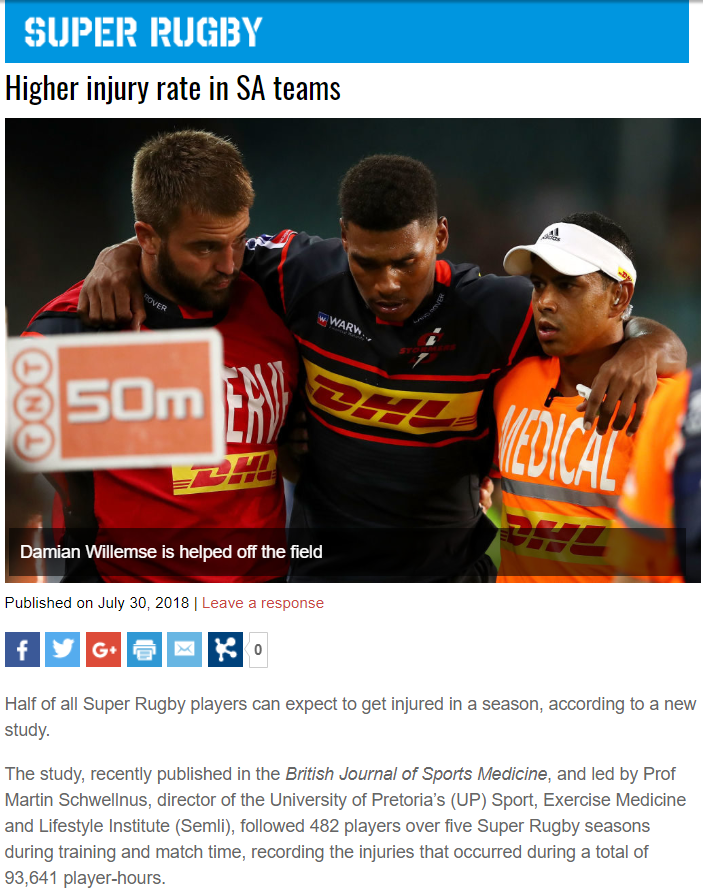
31 July 2018
A study recently published in the British Journal of Sports Medicine by University of Pretoria (UP) researchers found that there is a considerably higher match injury incidence in South African Super Rugby teams, where each team can expect to have two injuries occur per match.
The study was led by Prof Martin Schwellnus, Professor of Sport and Exercise Medicine and Director of UP’s Sport, Exercise Medicine and Lifestyle Institute (SEMLI). It followed 482 players over five Super Rugby seasons (2012 – 2016) during training and match time, recording the injuries that occurred during a total of 93 641 player hours. This is the largest study conducted to date in this tournament.
The study revealed that about 50% of all players can expect to suffer a time loss injury each season, which prevents the player from playing in matches or training for more than one day. Almost a third of players can expect to have an injury resulting in eight or more days off from training/match play, and one in eight players will sustain a severe injury that puts them out for more than 28 days, according to Prof Schwellnus.
The results from the five-year study revealed a total of 936 time loss injuries, of which, understandably, the vast majority (85.7%) occurred during matches and 14.3% occurred during training – a 62 times higher chance of getting injured in matches than during training. Most of these match injuries occurred in contact situations, with more than half of all injuries occurring during a tackle specifically.
Furthermore, eight percent of players suffered a minimal injury, 12% suffered mild injury, 17% suffered a moderate injury and 12% suffered a severe injury resulting in at least 28 days of time loss. Also, 50% of all the match injuries occurred in players’ legs (mostly in the thigh and knee), followed by the arms/shoulders (mostly the shoulder/clavicle). Less common were head/neck injuries (16%) and injuries to the trunk (11%).
Prof Schwellnus said “Rugby union is a contact sport involving frequent high-impact collisions. As a result, it has one of the highest rates of injury incidence among team sports. This years’ Super Rugby tournament is testament to this with headlines of injury crises in several teams, and key Springbok players not able to participate in important games this year.”
He said World Rugby, the international governing body for rugby union, periodically introduces changes to the laws of the game to enhance the playing and spectating experience and improve player welfare. Such law changes likely alter team strategy and player demands and may affect injury patterns over time. “There is therefore a need to conduct research studies over a number of seasons in order to analyse changes in injury profiles and introduce prevention programmes.”
The possible causes of injury are varied and complex, and could include conditioning levels, injury prevention and management procedures, or the travel demands during a tournament. Nevertheless, alarming statistics such as these call for the development of evidence-based, targeted interventions and guidelines for injury risk reduction (such as rule changes or the modification of players’ technique), since the effect of injury on player performance, health and career advancement, not to mention overall team performance can be devastating.
Prof Schwellnus and his research team at SEMLI, in collaboration with the South African Rugy Union and the medical doctors of the South African Super Rugby teams, have already started designing, implementing and testing these vitally important injury prevention programmes.
https://www.up.ac.za/en/Sport-Exercise-Medicine-and-Lifestyle-Institute/news/post_2707443-up-researchers-predict-injuries-in-super-rugby-teams
Prof Martin Schwellnus receives 2017 ACSM International Clinical Scholar Award
Prof Martin Schwellnus, Director of the Sport, Exercise Medicine and Lifestyle Institute (SEMLI) at the University of Pretoria (UP) has been selected as the recipient of the 2017 American College of Sport Medicine (ACSM) International Clinical Scholar Award. This award is made annually in recognition of the top athlete care and/or clinical medicine abstract or clinical case paper submitted at the ACSM’s yearly meeting, which attracted around 7000 delegates and is considered to be the most comprehensive sports medicine and exercise science conference in the world. This year’s event took place in Denver, Colorado from 30 May to 1 June, with a banquet and award ceremony on Friday evening, 2 June, during which Prof Schwellnus received the award in recognition of his submission titled, ‘Pre-Race Medical Screening and Educational Intervention Reduces Medical Complications: A SAFER Study in 153 208 Runners’. Read more at: http://www.up.ac.za/en/news/post_2502548-prof-schwellnus-receives-2017-acsm-international-clinical-scholar-award
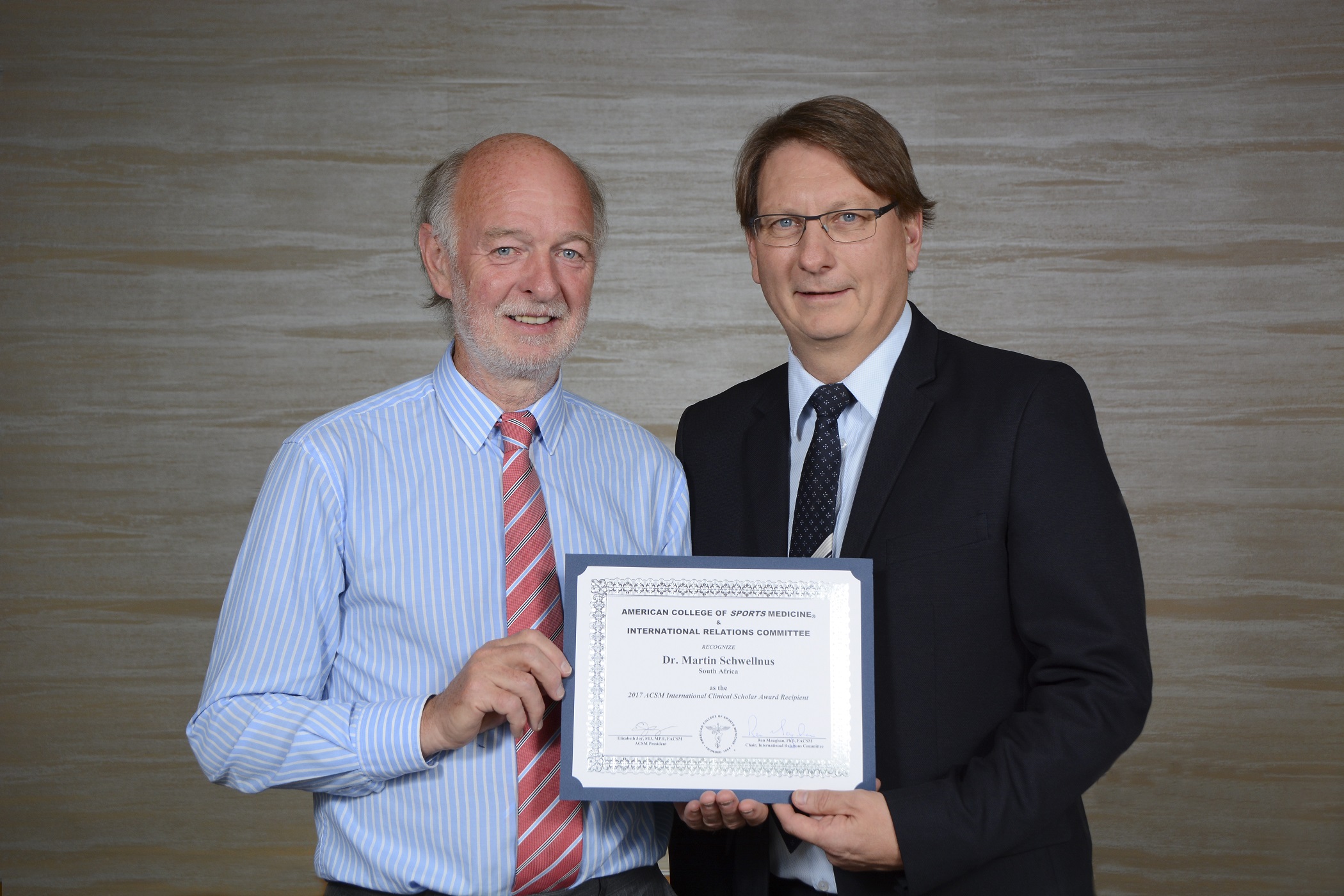
UP Expert Lecture 21 presented by Prof Martin Schwellnus
The Vice-Chancellor and Principal of the University of Pretoria, Prof Cheryl de la Rey, invites Prof Martin Schwellnus to present the 21st lecture in the prestigious UP Expert Lecture Series.
Title: “The drug everyone should take! Why, how, and what?”
Non-communicable diseases (NCDs) are responsible for >65% of all deaths worldwide. NCDs are also of pandemic proportions in Sub-Saharan Africa (SSA) and South Africa (SA). >80% of the NCD deaths are as a result of four disease groups: heart and blood vessel disease, cancers, diabetes and chronic lung disease. Tobacco use, harmful substance abuse, being sedentary, and unhealthy diets are the main risk factors responsible for abnormal changes in the human body that cause NCDs. These abnormal changes in the body are a raised blood pressure, being overweight/obese, a high blood sugar level, and abnormal fat concentrations in the blood. Scientific studies identified that there is one “drug” that positively alters all the abnormal changes in the body that are associated with NCDs, and therefore reduces the risk of dying from an NCD by 35-50%. This is a drug that everyone should take! Come and join a discussion on the why, how and what of this “wonder” drug.
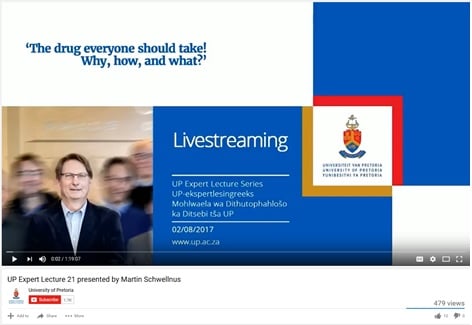
UP Expert Lecture 21 presented by Martin Schwellnus https://www.youtube.com/watch?v=7cP8XWFIrLk
SEMLI Research in Review:
In 2015/2016 research activities at the Institute focused on injuries and illness in sports, generating publications investigating the epidemiology of injury and illness in select sports, as well as investigations into the risks of injuries. Researchers contributed to studies on concussion in sport (in areas such as the diagnosis of concussion and return to play protocols after concussion), as well as the prevention and management of sudden cardiac arrest in sport.
The Institute was also represented on a consensus committee convened by the International Olympic Committee, chaired by Professor Schwellnus. This expert group produced two IOC consensus statements published in a special edition of the British Journal of Sports Medicine to coincide with the 2016 Rio Olympic Games. They reviewed the scientific evidence for the relationship of load (including rapid changes in training and competition load, competition calendar congestion, psychological load and travel) and health outcomes in sport, and provided athletes, coaches and support staff with practical guidelines for appropriate load management to reduce the risk of illness, injury and overtraining.
How much is too much? (Part 1) IOC consensus statement on load in sport and risk of injury. http://bjsm.bmj.com/content/50/17/1030
How much is too much? (Part 2) IOC consensus statement on load in sport and risk of illness.
http://bjsm.bmj.com/content/50/17/1043
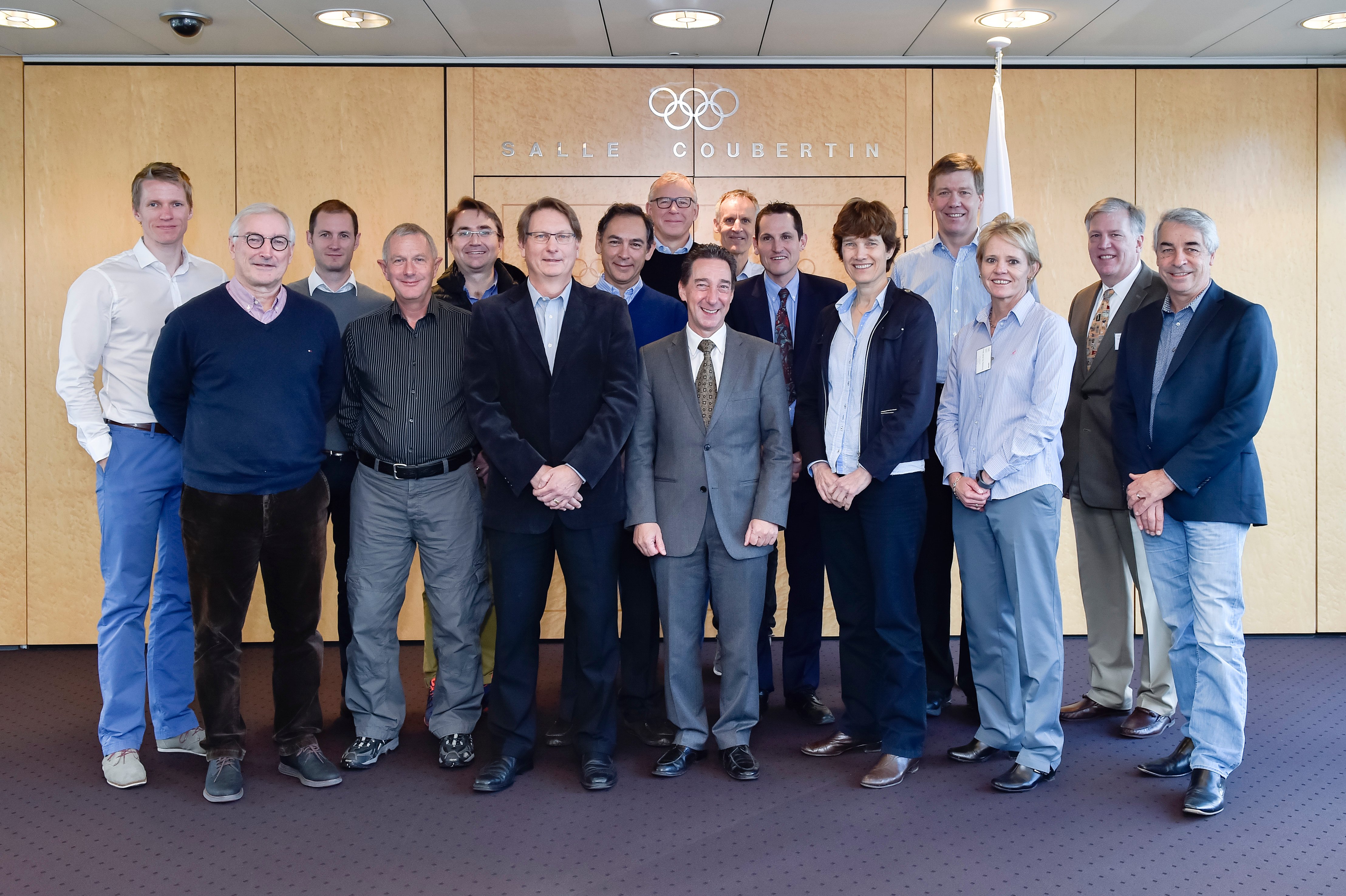

http://www.up.ac.za/en/research-innovation/news/post_2008223-prof-martin-schwellnus-to-head-new-sports-exercise-medicine-and-lifestyle-research-institute-at-up
 For the average marathon runner, excruciating pain is often inevitable during endurance runs, and popping a few painkillers before or during a race to make the pain more bearable seems like a no-brainer and is quite common.
For the average marathon runner, excruciating pain is often inevitable during endurance runs, and popping a few painkillers before or during a race to make the pain more bearable seems like a no-brainer and is quite common.




Get Social With Us
Download the UP Mobile App